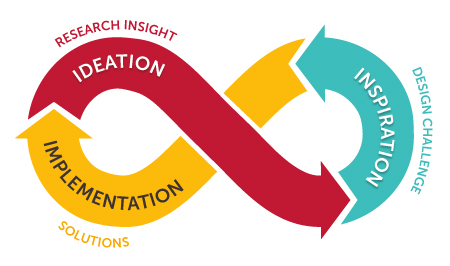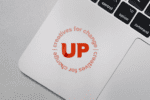Design Thinking
Human-Centered Design (HCD) has changed the way I think. Four years ago, Uptown Studios took on training in HCD as a process to better develop campaigns for our client base. In creating empathy for the end-user, not always just the clients, we are better equipped to achieve all the goals set for a project. All of the Uptown Studios teams are constantly challenged to create and recreate our processes, projects, and assumptions when we design for businesses and the community. The Uptown Studios company tagline, “Designs for Social Change,” is the way we describe our method of developing solutions for a wide range of problems.
The CEPS Design Challenge
As an interdisciplinary team of skilled design thinkers, we have had the privilege of creating a wide range of campaigns for entities in Sacramento. Over the years, one of my favorite projects was for an organization called Community Engaged Payee Support (CEPS). CEPS is a nonprofit organization that provides a wide range of assistance for individuals who have difficulty managing their day-to-day financial affairs. Our goal was to create a name and brand for the organization that encompassed all of the services CEPS provided for their clients.
 Wanting us to help them identify if a rebrand and rename of the organization was the right direction to help them achieve their future goals, we identified that a Human-Centered Design focus group would be the best method.
Wanting us to help them identify if a rebrand and rename of the organization was the right direction to help them achieve their future goals, we identified that a Human-Centered Design focus group would be the best method.
Our process started with developing the Inspiration/Design Challenge. A Design Challenge is a question in the formula “how might we ______.” Based on client meetings and initial discovery, the Design Challenge we developed was: “How might we develop a brand identity that communicates the purpose, diverse community, and range of services of CEPS?”
In Need Of Design Thinkers? We Have A Team Of Certified Design Thinkers That Will Take Your Business To The Next Level.
Objectives of the Rebrand
- Create a brand that clearly and accurately communicates the purpose and values of the organization.
- Develop a communications platform that makes it easy for employees, partners, and clients to talk about the organization and services.
- Elevate CEPS’ standing in the community.
- Grow the organization in an organic and meaningful way.
Design Thinking Focus Groups
With our Design Challenge identified, we held a 90-minute focus group to hear directly from the client, their partners, consumers, and community members. We learned how they felt about the CEPS organization and what the brand meant to them.
Along with other activities, we started with asking a group of 30+ attendees to give us some words to describe CEPS in the following areas:
“The Organization is….”
- Fun
- Energetic
- Playful
- Positive
- Compassionate
“What is CEPS meaning in the community?”
- Helpful
- Warm and respectful
- Non-judgmental
- Connected
“CEPS services are…”
- Professional
- Responsive
- Efficient
- Knowledgeable
Human-Centered Design Insights
From this information, we further developed our research which was then translated into insights of the client and what other companies that offer similar services are doing. We developed four insights for which we were able to create a path for solutions:
- How might we communicate CEPS advocacy for developing financial services which extend beyond clients’ bank accounts?
- How might we create a brand personality that reflects the genuine care CEPS has for their diverse community?
- How might we present CEPS’ dedication and trustworthiness in all the services they provide?
- How might we convey the value of the support system that CEPS provides?
We came to the conclusion the renaming of the organization was not the strongest path to take. However, we did find the organization could benefit greatly from updating and reinvigorating their current messaging and look and feel of the brand. In the long run, this process helped the organization grow. A brand that is easy for audiences to communicate makes it easier for a brand to grow.
We decided realigning the meaning of their acronym would be more useful—especially to their main audience. Through enhancing the brand and name that already existed, we created messaging that their audiences would remember.
Related: How A Design Thinking Focus Group Will Fix Your Target-Market Woes
This new name communicated with CEPS’ audiences outside of their main customers while accurately communicating the work the organization did for its clients.
We wanted to keep the community involved when choosing a new name for the organization that would help the engaged community provide feedback and guide the final decision.
New name options included:
- Community Engagement Payee Services, CEPS
- Community Engaged Payee Solutions, CEPS
- Community Engaged Payee Support, CEPS
After community and staff reviewed the names, the client decided Community Engaged Payee Support best fit the current and future goals of the company.
Creating the new brand and design:
The design needed to be reflective of the supportive, caring, and professional services that CEPS offered. The logo and style would be developed with ADA compliance, in mind.
The organization needed to pay special attention to the key messages that would be included in marketing materials and the website. Incorporating consistency in messaging along with the design would bind together the brand cohesiveness CEPS was striving for. Messaging needed to reflect who the organization was: warm, knowledgeable, trustworthy, nonjudgmental, compassionate, and energetic.
In Conclusion
When thinking about the work I have gotten to do using the HCD model, we have allowed ourselves to exercise many different parts of our skill sets and design and create outside of the box. You can learn more about Human-Centered Design.
Blog


